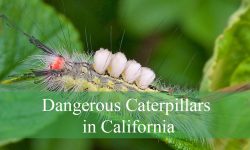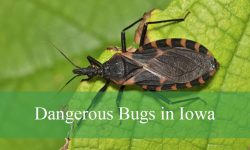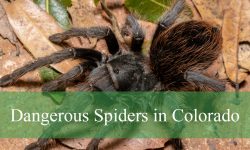The Lone Star State shelters a wide array of scorpion species, from slender bark scorpions to bulky, ground-dwelling types. While most are harmless, a few can deliver painful stings that cause swelling, numbness, or severe reactions. Knowing how to identify these species is essential for safety, especially in rural and desert areas.
Scorpions in Texas thrive in warm, dry environments and are most active at night when they hunt insects and other small prey. They often seek shelter under rocks, bark, and even inside homes, particularly during hot or dry periods. Their nocturnal habits and effective camouflage make encounters more common than people realize.
This guide covers six of the most dangerous scorpions in Texas, complete with pictures and identification details. You’ll learn about their appearance, habitat, and venom potency—helping you recognize which ones to avoid and how to stay safe while living or exploring in the Lone Star State.
Types of Dangerous Scorpions Found in Texas
Striped Bark Scorpion (Centruroides vittatus)
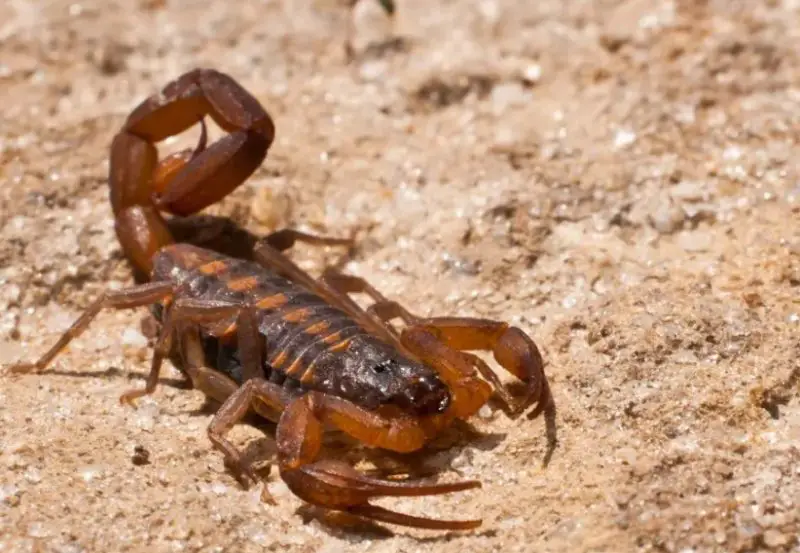
The Striped Bark Scorpion is the most common and widely distributed scorpion species in Texas. This species can be identified by its pale yellow body marked with two distinct dark stripes running down its back, giving it a striking appearance. Adults typically measure between 2 to 3 inches (5 to 7.5 cm) in length, with long slender pincers and a narrow, segmented tail ending in a curved stinger. Its body is well adapted for climbing and hiding, allowing it to thrive in both natural and urban environments.
This scorpion is nocturnal, emerging at night to hunt small insects, spiders, and other invertebrates. During the day, it seeks shelter under rocks, logs, bark, or within human structures such as garages and attics. Its ability to flatten its body makes it a skilled hider, and it’s not uncommon for homeowners to encounter it indoors during warm months. Despite its fearsome look, it prefers to flee rather than sting when disturbed.
The Striped Bark Scorpion is remarkably adaptable, living across nearly all of Texas—from arid deserts in the west to humid forests and grasslands in the east. It’s especially abundant in areas with plenty of ground cover and moisture. In dry regions, it tends to be more active at night, while in humid zones, it might seek higher ground or tree bark crevices to avoid dampness.
Its venom is not deadly to healthy adults but can cause significant pain, swelling, and localized numbness. Some individuals may experience nausea, dizziness, or allergic reactions depending on their sensitivity. The sting has been compared to that of a wasp or bee but can last longer and cause throbbing discomfort for several hours. Children, the elderly, and those with allergies should seek medical attention immediately after being stung.
Despite its painful sting, the Striped Bark Scorpion plays a valuable ecological role by controlling pest populations. It feeds on roaches, crickets, and other insects that often invade homes. Because of its abundance and nocturnal habits, it is the species most likely to sting humans in Texas, making it both the most familiar and the most feared scorpion in the state.
Texas Cave Scorpion (Pseudouroctonus reddelli)
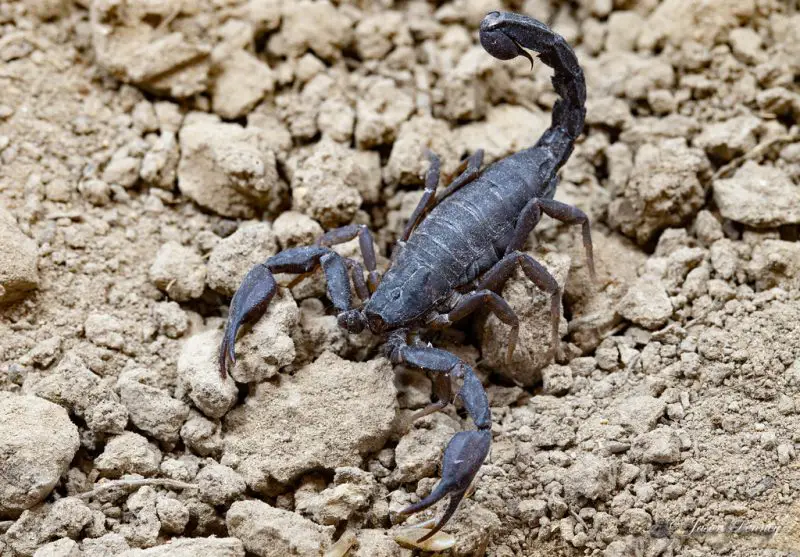
The Texas Cave Scorpion, sometimes called the Reddell’s Cave Scorpion, is a dark-colored species native to the limestone-rich regions of Central Texas. This medium-sized scorpion reaches about 2 to 2.5 inches (5 to 6.5 cm) in length. It is easily identified by its uniform dark brown to reddish-brown coloration, broad pincers, and slightly flattened body, which helps it maneuver through rocky crevices. Unlike the striped bark scorpion, it lacks the prominent dorsal stripes, giving it a more uniform look.
This species is primarily found in caves, rock outcrops, and other subterranean habitats. It prefers cool, moist environments and is often seen near cave entrances or under stones in shaded, humid areas. Because of its reclusive nature, encounters with humans are uncommon. However, people exploring caves or limestone ridges in Central Texas may occasionally spot one clinging to rock surfaces or hiding beneath loose debris.
Behaviorally, the Texas Cave Scorpion is solitary and nocturnal. It hunts small insects and other arthropods, relying on its pincers and venomous sting to subdue prey. Its dark coloration helps it remain camouflaged in low-light environments, making it a true specialist of underground ecosystems. During dry or hot seasons, it retreats deeper into caves to maintain hydration and temperature balance.
The sting of the Texas Cave Scorpion is considered painful but not medically significant. It produces localized pain, redness, and mild swelling that usually subside within a few hours. Severe allergic reactions are extremely rare. Unlike some bark scorpions, its venom lacks neurotoxins potent enough to cause systemic symptoms in humans, making it one of the less dangerous species in Texas.
Though not aggressive, this scorpion will defend itself if cornered. Because of its habitat preference, it plays an important ecological role by keeping insect populations in check inside cave ecosystems. For most Texans, it remains an elusive species, admired by enthusiasts and cave biologists for its adaptation to the underground world.
Giant Hairy Scorpion (Hadrurus arizonensis)
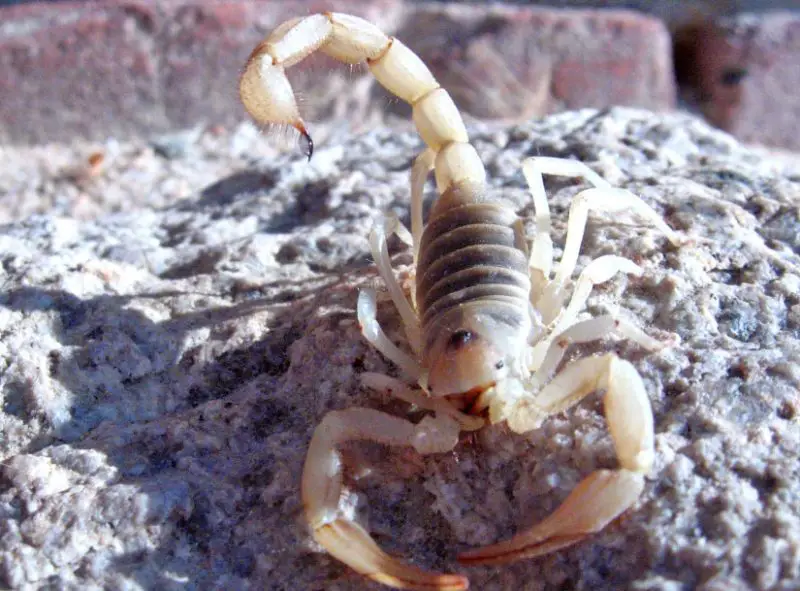
The Giant Hairy Scorpion, known as the largest scorpion species in North America, occasionally occurs in the far western deserts of Texas near the New Mexico border. Adults can reach impressive lengths of up to 5.5 inches (14 cm). Its appearance is unmistakable: a massive yellow body with dark shading on the carapace and long, hairy legs and tail segments. The dense hairs serve as sensory organs, allowing it to detect vibrations and prey movement in sandy soil.
This species inhabits arid desert and scrubland environments, preferring sandy or rocky terrains where it digs deep burrows to escape daytime heat. The burrows may extend several feet below the surface, offering protection from predators and temperature extremes. It is primarily nocturnal, emerging only after sunset to hunt insects, spiders, lizards, and even small mammals, displaying a powerful predatory behavior for its size.
Despite its intimidating size and defensive posture, the Giant Hairy Scorpion’s venom is relatively mild compared to smaller bark scorpions. Its sting causes intense, localized pain similar to a bee sting, sometimes followed by mild swelling and itching. Most healthy adults recover without medical treatment. However, the mechanical power of its sting—combined with large pincers—makes the experience extremely unpleasant.
This scorpion is generally non-aggressive toward humans and will only sting when provoked or handled. It tends to use its strong pincers for defense before resorting to its stinger. Because it thrives in remote desert areas, human encounters are infrequent, and it rarely enters homes or populated areas. Still, outdoor explorers and campers in West Texas should remain cautious at night when these scorpions are active.
The Giant Hairy Scorpion plays a crucial ecological role as both predator and prey in desert ecosystems. Its diet helps control insect and rodent populations, while it serves as food for owls, foxes, and other nocturnal hunters. Though frightening in appearance, it poses little real threat to humans and stands as a fascinating example of desert adaptation in the scorpion world.
Lesser Stripetail Scorpion (Vaejovis coahuilae)
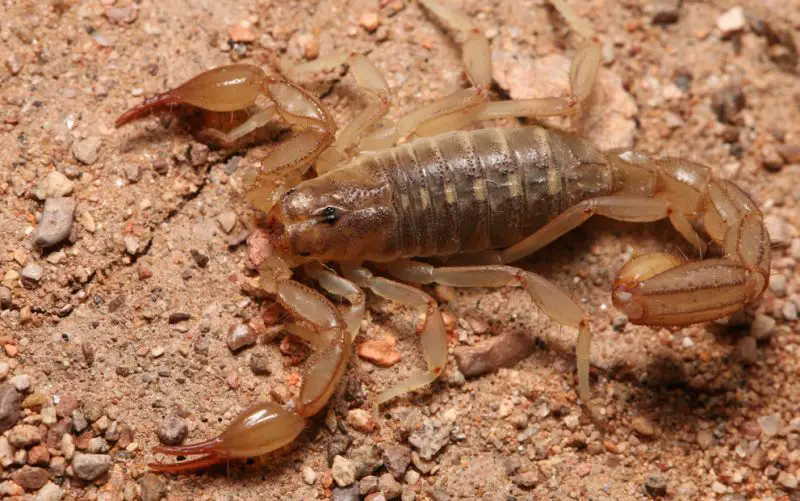
The Lesser Stripetail Scorpion is a medium-sized species commonly found in western and southern Texas, particularly in dry, rocky habitats and desert grasslands. Adults typically reach about 1.5 to 2 inches (4 to 5 cm) long. Its body is yellowish-brown with faint, darker striping on the tail and carapace. The tail segments are slightly thicker than those of bark scorpions, giving it a more robust appearance. Its pincers are short but strong, well-suited for grasping prey in tight spaces.
This species is nocturnal and spends the daytime hidden beneath rocks, debris, or within soil burrows. It becomes active at night to hunt insects and small arthropods, using its keen sensory hairs to detect movement. The Lesser Stripetail Scorpion thrives in areas with loose soil and scattered stones, often found in the Trans-Pecos region and extending into parts of South Texas. It can sometimes be seen after summer rains, when humidity drives it to the surface.
The sting of this scorpion is comparable to a bee sting—sharp, immediate, and painful, followed by mild swelling or redness. Its venom is not considered medically significant, and symptoms typically fade within a few hours. However, sensitive individuals may experience stronger reactions, including itching or numbness near the sting site. Medical treatment is rarely necessary unless allergic symptoms appear.
In behavior, this species is not aggressive toward humans and usually stings only when stepped on or accidentally handled. Because it lives primarily outdoors in semi-arid areas, human contact is limited. Gardeners and campers may occasionally find one beneath rocks or near firewood piles, especially in rural Texas.
The Lesser Stripetail Scorpion plays an important ecological role in maintaining insect population balance. Its preference for remote, dry habitats means it poses little threat to people, despite its menacing look. It serves as a reminder of the biodiversity of Texas’s desert ecosystems, where even small predators like this contribute to the natural food chain.
Stripe-tailed Scorpion (Paravaejovis spinigerus)
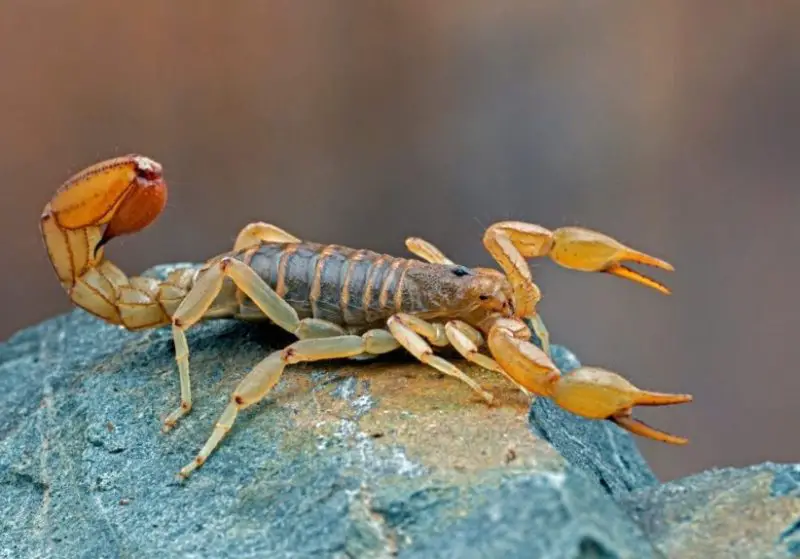
The Stripe-tailed Scorpion, also known as the Spinigerus Scorpion, is a small but striking species sometimes found in far western Texas, especially near desert and rocky slopes. It grows to about 1.5 to 2.5 inches (4 to 6 cm) in length and is easily identified by the distinct brown stripes running along its tail segments. Its overall color ranges from light tan to golden brown, blending perfectly with sandy soil and rocks.
This scorpion prefers dry, open habitats such as deserts, rocky washes, and scrublands. It spends daylight hours hidden under stones or within shallow burrows to escape heat and predators. At night, it becomes active, hunting insects, spiders, and other small arthropods. Its agility and camouflage make it an effective nocturnal predator, rarely noticed even in places where it is common.
The sting of the Stripe-tailed Scorpion is mildly venomous, producing pain similar to a wasp sting. Most people experience only temporary discomfort, redness, and slight swelling. Serious reactions are rare, but allergic individuals may feel dizziness or numbness around the site. The venom primarily acts as a defensive and predatory tool rather than a threat to humans.
This species exhibits calm behavior and is not known to be aggressive. When disturbed, it usually retreats or remains motionless, relying on its camouflage. Only when handled or cornered will it sting in defense. Because it prefers remote desert areas, it rarely comes into contact with people and is not considered a household pest.
Despite its modest size, the Stripe-tailed Scorpion is an essential part of the desert ecosystem, helping regulate insect populations. Its presence indicates a healthy habitat with diverse microfauna. For wildlife enthusiasts exploring western Texas, spotting one under ultraviolet light—where it glows bright blue-green—is an unforgettable experience.
Arizona Bark Scorpion (Centruroides sculpturatus)
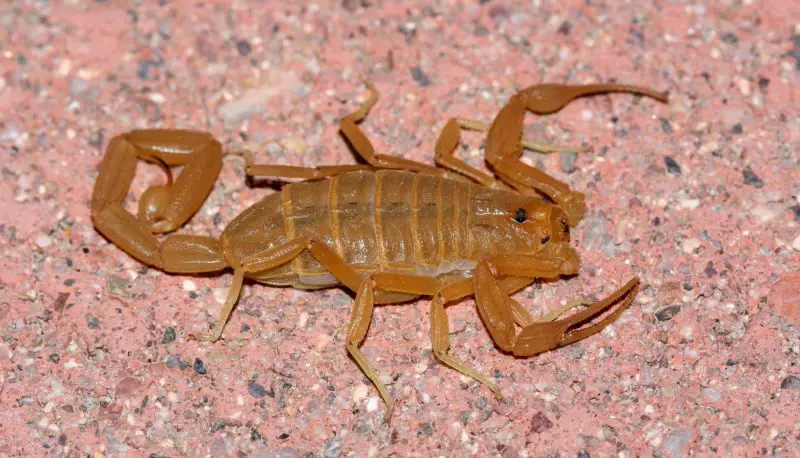
The Arizona Bark Scorpion is the most venomous scorpion in North America and occasionally appears in far western Texas near the New Mexico and Arizona borders. Adults typically measure 2.5 to 3 inches (6 to 7.5 cm) long, with a slender yellow-tan body, thin pincers, and a narrow, curved tail. It closely resembles the Striped Bark Scorpion but can be distinguished by its more elongated body and lack of distinct dorsal stripes.
This species is extremely adaptable and can live in desert canyons, rocky slopes, and urban environments. It prefers to hide under rocks, tree bark, or within cracks in walls and wood piles during the day. Nocturnal by nature, it hunts insects, spiders, and other small creatures at night, using its acute sense of vibration and heat to locate prey. It is also known to climb walls and ceilings, often entering homes in search of shelter and moisture.
The Arizona Bark Scorpion’s venom is highly neurotoxic and poses a serious threat to humans. Its sting causes immediate, intense pain, followed by tingling, numbness, and sometimes muscle spasms or difficulty breathing. While fatalities are extremely rare due to medical treatment availability, young children, the elderly, and individuals with allergies are at higher risk of severe reactions. Antivenom is available and typically used for severe envenomations.
This species is generally not aggressive but will sting defensively if threatened or trapped against the skin. Because it’s small and slender, it can hide in clothing, shoes, and bedding, increasing the chance of accidental stings indoors. Areas with rock walls, wood piles, or loose bark are prime habitats, especially near desert communities close to the Texas-New Mexico border.
Despite its dangerous reputation, the Arizona Bark Scorpion plays an important role in desert ecosystems by controlling insect populations. Its presence often indicates a healthy, balanced environment. However, due to its potent venom and ability to coexist in human structures, it remains the most feared and medically significant scorpion species occasionally encountered in Texas.
Tips to Stay Safe from Scorpions in Texas
Avoid Handling Scorpions Directly
Never attempt to pick up or handle a scorpion with bare hands, even if it appears dead. Scorpions can still sting reflexively after death, and many species are skilled at hiding. If you need to remove one, use long tongs or a jar with a lid to capture and relocate it safely.
Shake Out Shoes, Towels, and Clothing
Scorpions often crawl into dark, warm places such as shoes, clothes, and towels left on the floor overnight. Always shake out your shoes and clothing before putting them on—especially if you live in an area where scorpions are common. This simple habit prevents accidental stings.
Wear Gloves When Working Outdoors
When gardening, collecting firewood, or moving rocks and debris, wear sturdy gloves to protect your hands. Scorpions love to hide under bark, stones, and logs during the day, and accidental contact can easily lead to a sting.
Seal Entry Points Around Your Home
Inspect and seal cracks, gaps, and holes around windows, doors, vents, and foundation walls. Scorpions can squeeze through tiny spaces, so sealing potential entry points is one of the best ways to keep them outside. Install weather stripping and door sweeps to reduce indoor access.
Reduce Outdoor Clutter and Debris
Scorpions thrive in cluttered outdoor environments. Keep your yard tidy by removing piles of wood, rocks, leaf litter, and construction materials where they might hide. Maintain a gap between bushes or mulch and your home’s foundation to reduce shelter areas.
Eliminate Insects—Their Main Food Source
Scorpions are attracted to areas with abundant insect life. By controlling crickets, cockroaches, and spiders around your property, you’ll make your home less appealing to them. Use insect traps, maintain clean surroundings, and consider periodic pest control treatments.
Use UV Light to Check for Scorpions at Night
Scorpions glow under ultraviolet (UV) light, which makes them easy to spot after dark. If you live in a high-risk area, keep a small UV flashlight handy and check around porches, garages, or sleeping areas occasionally. This is especially helpful before camping or setting up sleeping gear outdoors.
Keep Bedrooms and Sleeping Areas Clear
Avoid leaving blankets or clothing on the floor, and keep beds a few inches away from walls. Scorpions can climb vertical surfaces, so it’s wise to check bedding and walls near sleeping areas during peak activity months.
Educate Children About Scorpion Safety
Teach kids not to touch or play with scorpions. Explain that even small ones can sting painfully. Encourage them to report any sightings to an adult immediately rather than trying to handle the scorpion themselves.
Seek Medical Attention for Severe Stings
While most scorpion stings in Texas are not life-threatening, severe pain, difficulty breathing, muscle twitching, or allergic reactions require professional care. Apply a cold compress to reduce swelling and seek medical help promptly, especially for children, older adults, or those with known allergies.
FAQs about Dangerous Scorpions in Texas
Are there dangerous scorpions in Texas?
Yes. While most scorpions in Texas are not life-threatening, several species can deliver painful and medically significant stings. The most common and concerning is the Striped Bark Scorpion (Centruroides vittatus), which is responsible for most stings across the state. Other species, such as the Texas Cave Scorpion and Giant Hairy Scorpion, can also cause pain and discomfort but are less dangerous to humans.
Which is the most venomous scorpion in Texas?
The Arizona Bark Scorpion (Centruroides sculpturatus) is the most venomous scorpion occasionally found in far western Texas. Its venom is neurotoxic and can cause intense pain, muscle spasms, and numbness. However, it is not native to most of Texas and appears only in border regions near New Mexico and Arizona. Prompt medical attention and antivenom can prevent serious complications.
Where are scorpions most common in Texas?
Scorpions are widespread across the state but are most abundant in Central, South, and West Texas, where the climate is hot and dry. The Hill Country, Trans-Pecos, and desert regions provide ideal conditions for species like the Striped Bark Scorpion and Lesser Stripetail Scorpion. They often seek shelter under rocks, woodpiles, tree bark, or even inside homes during hot or dry weather.
What time of year are scorpions most active in Texas?
Scorpions in Texas are most active from late spring through early fall, typically April to October, when temperatures are warm. They are nocturnal hunters, emerging at night to feed on insects and other small creatures. During the colder months, they hide in burrows or seek shelter indoors to escape the chill.
What should I do if I’m stung by a scorpion in Texas?
If stung, immediately clean the area with soap and water, apply a cold compress to reduce swelling, and avoid scratching or pressing the sting site. Most stings only cause localized pain and redness. However, if you experience severe pain, numbness, muscle twitching, or breathing difficulty, seek medical attention right away. In rare cases, especially with the Arizona Bark Scorpion, antivenom may be required.
How can I keep scorpions out of my home in Texas?
To prevent scorpions from entering your home, seal cracks and gaps around windows, doors, and foundation walls. Keep firewood, rocks, and debris away from your house, as these provide hiding spots. Install door sweeps, use sticky traps along walls, and reduce insect populations, which serve as scorpion prey. Regular pest control treatments are also effective in high-risk areas.
Do scorpions glow under UV light?
Yes. All scorpions, including those in Texas, glow a bright blue-green color when exposed to ultraviolet (UV) light. This natural fluorescence makes them easy to spot at night using a handheld UV flashlight—a technique often used by researchers, pest control professionals, and campers to locate scorpions safely.
Are scorpions aggressive toward humans?
No. Scorpions are generally not aggressive and prefer to flee rather than fight. They only sting when threatened, stepped on, or accidentally handled. Most scorpion stings in Texas occur when people reach into dark spaces, put on shoes left outside, or roll over one in bed.
Do scorpions in Texas pose a risk to pets?
Yes, though most stings are not fatal. Pets—especially small dogs and cats—can experience pain, swelling, or allergic reactions similar to humans. If your pet shows symptoms such as excessive drooling, trembling, or difficulty breathing after a sting, contact a veterinarian immediately.
Should I kill scorpions if I find them near my home?
It’s not always necessary to kill scorpions. They play an important ecological role in controlling insect populations. However, if they are found inside the house or in high-risk areas, it’s wise to relocate or safely remove them using tongs or by contacting a pest professional. Regular maintenance and habitat control are more effective long-term solutions than killing individual scorpions.



